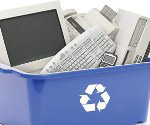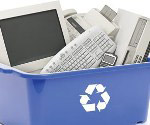
Retiring IT Assets for Green Reasons
- By Steve Suesens
- May 03, 2010
 IT asset management – which helps businesses prolong equipment longevity and increase ROI – is a key driver to developing a green IT policy that over time will yield positive returns for the environment and generate green for your bottom line. But, according to the U.S. Environmental Protection Agency, 134.5 million IT assets currently sit idle in America alone – and a mere 18 percent are likely to be recycled. The problem is only magnified on the global scale.
IT asset management – which helps businesses prolong equipment longevity and increase ROI – is a key driver to developing a green IT policy that over time will yield positive returns for the environment and generate green for your bottom line. But, according to the U.S. Environmental Protection Agency, 134.5 million IT assets currently sit idle in America alone – and a mere 18 percent are likely to be recycled. The problem is only magnified on the global scale.
By combining short-term actions with long-term planning, organizations can begin to develop a comprehensive green IT asset lifecycle management program that will help mitigate risks and deliver cost and productivity benefits. By strategically applying IT asset management best practices, you can get the most out of your IT assets to efficiently maintain business momentum and employee productivity.
As you get started, be sure to distinguish between the major stages of the IT asset lifecycle: assessment, procurement, service, management and retirement. How each stage is handled depends on the type of equipment being managed within your organization. For instance, there are specific lifecycle management considerations for data center equipment, printer fleets, and PCs and laptops.
Understanding what you have and how it is being used is a key first step in the assessment phase. Periodic audits will identify equipment that is not in use or underutilized and that should be consolidated, removed or recycled. Using this information, you can develop a complete inventory of your IT assets. As you look at how these assets impact your bottom line, you should also consider overhead costs, including floor space for equipment and storage and IT staff management and administration.
Procuring eco-friendly equipment is a simple way to implement green IT asset management. You should prepare guidelines for green procurement that include negotiation terms with hardware and software vendors and other IT service providers. These "green" procurement guidelines can be incorporated into your organization's general IT procurement policy.
If you need to purchase new equipment, here are a few tips for identifying what to replace and when:
- Depending on usage, you should replace computers every three to five years. If you have come to that point, you may want to consider purchasing laptops instead of desktops because the typical laptop only uses around 15-25 watts per hour. Desktop PCs use around 150 watts.
- CRT monitors should already be replaced with flat panel LCDs because they use half has much power. If you’ve been putting off replacing your old monitors because they still work, it may actually be costing you more to keep them running.
- Servers that are more than four years old may also be using more electricity than needed. Chip manufactures like Intel have created new processors that reduce the amount of power consumption in servers.
Your computer will be outmoded someday, but you can prolong its useful life by taking care of your technology inventory. A maintenance program should be in place for all equipment – specifying, for example, to have all of your computers cleaned at least once a year, consider RAM upgrades vs. purchasing an entirely new system, and buy high-quality peripherals that will last. A high-quality monitor should last for at least six to seven years. When it comes time to upgrade your PC, the monitor can be used with a new computer. If you can extend the lifecycle of equipment, you can reduce waste.
Maintenance strategies must evolve to factor in environmental impacts, consequences, and costs for key technologies. Improved asset management and preventive maintenance programs can save energy consumption, which directly impacts both carbon emissions and profitability.
As new technology becomes old technology, some companies stockpile their old machines and are reluctant to part with them due to concerns about data ending up in the wrong hands or fears that old equipment will simply end up in a landfill. CIOs and IT managers often feel better knowing that old and unused equipment is tucked safely away. At corporate campuses and in the smallest offices, a veritable “technology graveyard” can often be found.
Of course, this is not the best approach. As technology becomes too old to upgrade, no longer functions properly, or will need extensive repairs to get back to workable condition, it's time to recycle the components. One of the fastest growing forms of waste in the U.S. is electronic equipment, called e-waste. Unfortunately only 15-20 percent of outdated electronic equipment is recycled properly, and the remaining equipment usually ends up at landfills, causing chemicals such as lead, mercury, and chromium to seep into the water supply. It should go without saying that responsible recycling of old electronic equipment needs be a part of IT asset management plan.
If the equipment is still working and less than five years old, you should consider donating it for refurbishing and reuse by schools or charities. If the equipment is older than five years or is broken, it should be sent to a reputable computer recycler who will salvage reusable parts and safely remove and dispose of hazardous chemicals. Regardless of age and method of disposal, you should make sure that all data has been removed from the device prior to re-deployment or recycle. You can find a list of refurbishers and recyclers, as well as other helpful information on disposing of e-waste, on the EPA Website.
It is important to have a comprehensive plan that looks at all aspects of IT asset management and identifies opportunities to go green. Green IT is, of course, not only good for business, but it’s also good for brand image, the Earth and the rest of us as well. It also happens to be an area where significant dollar savings can be achieved with the right level of commitment and attention to process.
About the Author
Steve Suesens is category manager for Staples Technology Solutions, a part of Staples, Inc., that provides business customers with access to a range of technology essentials – from data center solutions and printer fleet management services to network services and everyday desktop technology products.